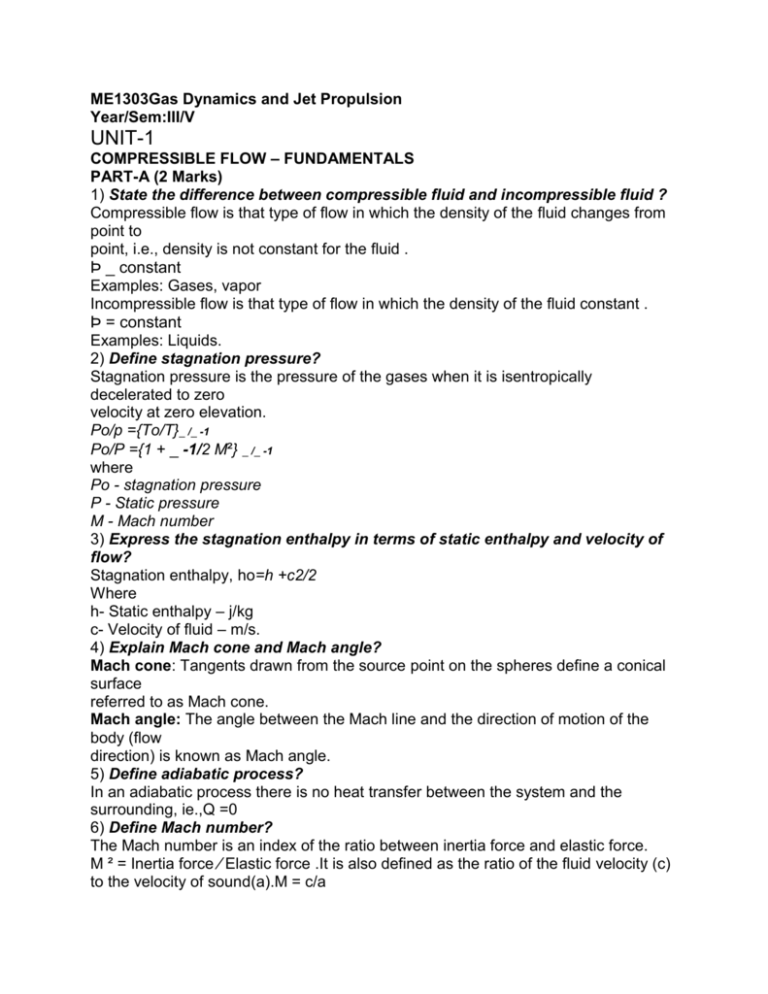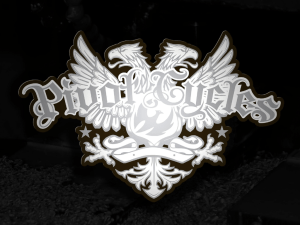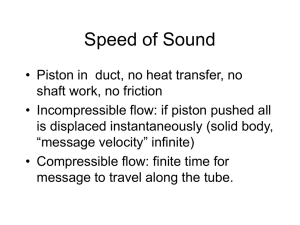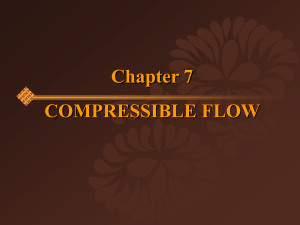ME1303Gas Dynamics and Jet Propulsion (two
advertisement

ME1303Gas Dynamics and Jet Propulsion
Year/Sem:III/V
UNIT-1
COMPRESSIBLE FLOW – FUNDAMENTALS
PART-A (2 Marks)
1) State the difference between compressible fluid and incompressible fluid ?
Compressible flow is that type of flow in which the density of the fluid changes from
point to
point, i.e., density is not constant for the fluid .
Þ _ constant
Examples: Gases, vapor
Incompressible flow is that type of flow in which the density of the fluid constant .
Þ = constant
Examples: Liquids.
2) Define stagnation pressure?
Stagnation pressure is the pressure of the gases when it is isentropically
decelerated to zero
velocity at zero elevation.
Po/p ={To/T}_ /_ -1
Po/P ={1 + _ -1/2 M²} _ /_ -1
where
Po - stagnation pressure
P - Static pressure
M - Mach number
3) Express the stagnation enthalpy in terms of static enthalpy and velocity of
flow?
Stagnation enthalpy, ho=h +c2/2
Where
h- Static enthalpy – j/kg
c- Velocity of fluid – m/s.
4) Explain Mach cone and Mach angle?
Mach cone: Tangents drawn from the source point on the spheres define a conical
surface
referred to as Mach cone.
Mach angle: The angle between the Mach line and the direction of motion of the
body (flow
direction) is known as Mach angle.
5) Define adiabatic process?
In an adiabatic process there is no heat transfer between the system and the
surrounding, ie.,Q =0
6) Define Mach number?
The Mach number is an index of the ratio between inertia force and elastic force.
M ² = Inertia force ⁄ Elastic force .It is also defined as the ratio of the fluid velocity (c)
to the velocity of sound(a).M = c/a
7) Define zone of action and zone of silence ?
The region inside the Mach cone is called the zone of action and the region outside
the Mach
cone is termed as the zone of silence.
8) Define closed and open system?
A closed system does not permit any mass transfer, only energy transfer takes
place.
In open system both the mass and energy transfer takes place.
9) What is the difference between intensive and extensive properties?
Intensive properties:
These properties are independent on the mass of the system.
Example: Pressure, Temperature, etc
Extensive properties:
These properties are dependent upon the mass of the system.
Example: Total volume, Total energy, etc.
10) Distinguish between Mach wave and normal shock?
Mach Wave: The lines at which the pressure difference is concentrated and which
generate cone
are called Mach lines or Mach waves.
Normal shock: A shock wave is nothing but a steep finite pressure wave. When the
shock wave
is right angle to the flow, it is called normal shock.
Unit -2
DUCTS FLOW THROUGH VARIABLE AREA
PART-A (2 Marks)
1) Differentiate Adiabatic and Isentropic process.
Adiabatic process:
In a process there is no heat transfer from the fluid to surroundings or from the
surroundings to
the fluid.
Isentropic process:
In a isentropic entropy remains constant and it is reversible .During this process
there is no heat
transfer from the fluid to surroundings or from the surroundings to the fluid.
Therefore an
isentropic process can be stated as reversible adiabatic process.
S = constant
Q =0
2) Differentiate nozzle and diffuser ?
Nozzle:
It is a device which is used to increase the velocity and decrease the pressure of
fluids.
Diffuser: It is a device which is used to increase the pressure and decrease the
velocity of fluids.
3) What is Impulse function ?
The sum of pressure force ( pA ) and impulse force ( þAc² ) gives Impulse function
(F)
F = pA + þac²
4) Differentiate between adiabatic flow and diabatic flow ?
Diabatic flow :
Flow in a constant area duct with heat transfer and without friction is known as
diabatic flow
(Rayleigh flow)
Adiabatic flow:
Flow in a constant area duct with friction and without heat transfer is known as
adiabatic flow
(Fanno flow).
5) State the expression for dA/A as a function of Mach number ?
dA/A =dp/þc² [ 1-M² ]
6) Give the expression for T/To and T/T* for isentropic flow through variable
area interms of
Mach number ?
To/T =1+[_-1/2]M²
To/T = 1
1+ [_-1/2] M²
T*/T =2 /_+1 + [_-1/ _+1] M²
T/T* = 1
2/ _+1 + [_-1/ _+1] M²
7) Draw the variation of Mach number along the length of a convergent
divergent duct when it
acts as a (a) Nozzle (b) Diffuser (c) Venturi
M=1 M=1 M=1
M<1 M>1 M>1 M<1 M<1 M<1
Nozzle Diffuser Venturi
8) What is chocked flow through a nozzle?
The mass flow rate of nozzle is increased by decreasing the back pressure. The
maximum mass flow conditions are reached when the throat pressure ratio achieves
critical value. After that there is no further increase in mass flow with decrease in
back pressure .This condition is called chocking. At chocking condition M=1.
9) What type of nozzle used for sonic flow and supersonic flow?
Constant area duct nozzle is used for sonic flow and divergent nozzle is used for
supersonic flow.
10) When does the maximum mass flow occur for an isentropic flow with
variable area?
Mass flow rate will be maximum at throat section where the Mach number is one.
Unit -3
DUCTS FLOW THROUGH CONSTANT AREA
PART-A (2 Marks)
1) What are the consumption made for fanno flow?
_ One dimensional steady flow.
_ Flow takes place in constant sectional area.
_ There is no heat transfer
_ The gas is perfect with constant specific heats.
2) Differentiate Fanno flow and Rayleigh flow?
Rayleigh flow:
Flow in a constant area duct with heat transfer and without friction is known as
Rayleighs flow.
Fanno Flow:
Flow in a constant area duct with friction and without heat transfer is known as
Fanno flow.
3) Explain chocking in Fanno flow?
In a fanno flow, subsonic flow region, the effect of friction will increase the velocity
and Mach number and to decrease the enthalpy and pressure of the gas.
In supersonic flow region, the effect of friction will decrease the velocity and Mach
number and to increase the enthalpy and pressure of the gas. In both cases entropy
increases up to limiting state where the Mach number is one(M=1) and it is constant
afterwards. At this point flow is said to be chocked flow.
4) Explain the difference between Fanno flow and Isothermal flow?
5) Write down the ratio of velocities between any two sections in terms of their
Mach number
in a fanno flow ?
[1+[_-1/2] M1²]½
C2/C1=M1/M2
[1+[_-1/2] M2²]½
6) Write down the ratio of density between any two section in terms of their
Mach number in
a fanno flow?
Þ2/ Þ1= M1/M2 [1+ [_-1/2] M1²]½
[1+ [_-1/2] M1²]½
7) What are the three equation governing Fanno flow?
Energy equation
Fanno flow Isothermal flow
Flow in a constant area
duct with friction and
without heat transfer is
known as fanno flow.
Static temperature is not constant.
Flow in a constant area duct with
friction and the heat transfer is
known as isothermal flow.
Static temperature remains
constant.
Continuity equation
Equation of state
8) Give the expression to find increase in entropy for Fanno flow?
S2-S1
R =_n M1/M2 [1+ [_-1/2] M1²]_ +1/2(_ -1)
[1+ [_-1/2] M1²]_ +1/2(_ -1)
9) Give two practical examples where the Fanno flow occurs?
Flow in air breathing engines
Flow in refrigeration and air conditioning
Flow of fluids in long pipes.
10) What is Rayleigh line and Fanno line?
Rayleigh line:
Flow in a constant duct area with heat transfer and without friction is described by a
curve is
known as Rayleigh line.
Fanno Line:
Flow in a constant duct area without heat transfer and with friction is described by a
curve is
known as Fanno line.
Unit-4
NORMAL SHOCK
PART-A (2 Marks)
1) What is mean by shock wave ?
A shock wave nothing but a steep finite pressure wave.The shock wave may be
described as a
compression wave front in a subsonic flow field across which there is abrupt change
in flow
properties.
2) What is mean by Normal shock?
When the shock wave at right angle to the flow it is called normal shock.
3) What is oblique shock?
When the shock wave is inclined at an angle to the flow it is called oblique shock.
4) Define strength of shock wave?
It is defined as the ratio of the difference in downstream and upstream shock
pressure (py-px) to
upstream shock pressure (px)it is denoted by £
£ =py –px/px
5) What are applications of moving shock wave ?
It is used in
Jet engines
Shock tubes
Supersonic wind tunnel
Practical admission turbines
6) Shock waves cannot develop in subsonic flow? Why?
In subsonic flow the velocity of fluid is less than the velocity of sound .Due to this
reason,
deceleration is not possible in subsonic flow so shock waves cannot develop in
subsonic flow.
7) Define compression and rarefaction shock? Is the latter possible?
A shock wave which is at a higher pressure than the fluid into which it is moving is
called a
compression wave.
The shock wave which is at a lower pressure than the fluid into which it is moving is
called a
expansion shock wave or rarefaction shock wave.
It is not possible.
8) State the necessary conditions for a normal shock to occur in compressible
flow?
The compression wave is to be at right angle to the compression flow
Flow should be supersonic
9) Give the difference between normal and oblique shock?
Normal shock Oblique shock
Shock wave is right angle to the
flow
One dimensional flow
Shock wave is inclined at an angle to
the flow.
Two dimensional flow.
10) what are the properties change across a normal shock ?
stagnation pressure decreases
stagnation temperature remains const
static pressure and temperature increases
Unit -5
PROPULSION
PART-A (2 Marks)
1) Differentiate jet propulsion and rocket propulsion (or) differentiate between
air breating
and rocket propulsion?
Sno Jet propulsion Rocket propulsion
1. Oxygen required for
combustion purpose is taken
from the atmosphere.
Oxygen is filled in a tank in the rocket
engine itself and used for combustion purpose
2. Altitude limitation No altitude limitation
3. Flight speed always less than jet
velocity.
Flight speed can be greater than jet velocity.
4. Reasonable efficiency Low efficiency expect at extremely high flight speed
5. Trust decreases with altitude Trust improves slightly with altitude
2) What is monopropellant? Give one example for that?
The liquid propellant both the fuel and oxidizer in a single chemical is known as a
monopropellant .It is stable at normal ambient conditions and liberates thermal
chemical energy
on heating.
Example:
Nitroglycerine
Nitro methane
3) What is bipropellant?
If the fuel and oxidizer are different from each other in its chemical nature , the
propellant is
called the bipropellant.
Example:
Liquid oxygen –gasoline.
Hydrogen peroxide – hydrazine
4) Classify the rocket engines based on sources of energy employed?
On the basis of source of energy employed rocket engine is classified as:
_ Chemical rocket engines
_ Solar rocket engines
_ Nuclear rocket engines
_ Electrical rocket engines
5) What is specify impulse of rocket?
The thrust developed by unit weight flow rate of the propellant is known as specific
impulse.
Isp =F/Wp
6) Define specific consumption?
The propellant consumption rate per unit thrust is known as specific propellant
consumption.
SPC =Wp/F
7) What is weight flow co-efficient?
It is the ratio of propellant flow rate to the throat force
Cw =Wp/poA*
8) What is IWR?
IWR (impulse to weight ratio) is the ratio of total impulse of the rocket to the total
weight of the
rocket.
IWR = I total/Wtotal
9) What is thrust co-efficient?
It is the ratio of the thrust to the thrust force
Cf = F/po A*
10) Define propulsive efficiency?
It is ratio of the propulsive power to the power output of the engine
p =propulsive power/power output of the engine.




![Electrical Safety[]](http://s2.studylib.net/store/data/005402709_1-78da758a33a77d446a45dc5dd76faacd-300x300.png)



